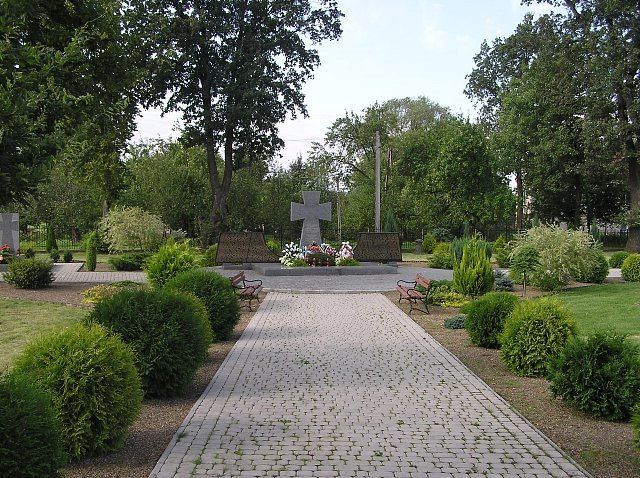Start date March 3, 1945 | ||
 | ||
The Pawłokoma massacre refers to the murder of Ukrainian civilians by Poles at the end of World War II in Pawłokoma 40 km (25 mi) west of Przemyśl in Poland, on March 3, 1945. In the period before the outbreak of World War II there were 1370 residents including 1190 Ukrainians, 170 Poles and 10 Jews.
Contents
Prelude
According to Canadian historian Petro Potichny, from 1938–41 after the Molotov-Ribbentrop pact the village was located in the Drohobych oblast and annexed to the Ukrainian SSR. During the Soviet occupation sixteen villagers were arrested. During the subsequent German occupation, nine Ukrainians were arrested and 193 were deported as Ostarbeiter to Germany. Among those murdered by the Poles in 1943 was the active community leader, teacher and bandurist Mykola Levytsky.
One story reports that on January 21, 1945 a unit of the Ukrainian Insurgent Army appeared in the village and kidnapped seven Poles and one pro-Polish Ukrainian woman, including the commune leader of Pawłokoma — Kacper Radoń. They never returned to the village, and were assumed to have been killed. The Polish community tried to discover their place of burial from the Ukrainians. However there was no response. Poles from nearby Dynow and from Pawłokoma appealed to the mayor of Powiat to send troops to extract information about the missing people. These meetings turned into anti-Ukrainian demonstrations. Retaliation occurred.
According to another story reported by Polish-Ukrainian historian Eugeniusz Misiło, the Poles who were supposedly kidnapped and murdered in Pawłokoma and in neighboring villages by UIA, were actually kidnapped by the Soviet NKVD in an attempt to start a series of retaliations.
Massacre
On 2–3 March 1945, approximately 366 (or 150 according to Zdzislaw Konieczny) Ukrainian and a few Polish inhabitants of Pawłokoma were murdered, by a former Armia Krajowa unit, commanded by Józef Biss "Wacław" aided by Polish self-defense groups from nearby villages. The victims were held in a local church, interrogated (some were possibly tortured) and then taken to a local cemetery where they were executed. Only women with small children (below 10 years old) survived. According to historian Zdzisław Konieczny, the AK group killed some 150 Ukrainian men in Pawlokoma, while women and children were spared and ordered to march to Ukraine. An inscription on the memorial in Pawłokoma places the number of victims of the 1945 massacre at 365.
The massacre was believed to be an act of retaliation for an earlier alleged murder by Ukrainian Insurgent Army of 9 (or 11) Poles.
Aftermath
The Pawłokoma massacre is one of the better-known examples of Ukrainian civilians murdered by different Polish groups in February–April 1945. Similar massacres followed in other nearby villages, including Łubna, Małkowice and Piskorowice.
On September 4, 1945 after interrogation, Józef Biss was sentenced to seven years imprisonment for involvement in anti-Communist activities and evasion of a military service.
The Ukrainian church in which the Ukrainian villagers were murdered was destroyed by the Roman Catholic parishioners of the village in 1965. Part of the bell tower remains. The Ukrainian cemetery was transformed into a dump yard.
Several bodies of the victims were exhumed in 1952. The Polish Institute of National Remembrance (IPN) has been conducting an investigation of the crime since 20 September 2001. The ongoing investigation is (as of May 2006) still inconclusive.
On May 13, 2006 Polish president Lech Kaczyński and Ukrainian president Viktor Yushchenko attended a ceremony at the site to pay tribute to the victims, and to encourage historical reconciliation between Poland and Ukraine. After celebrating a panychydy, the presidents also paid tribute to all Polish victims who died in Pawłokoma.
Controversy
While sources differ on specific issues like the number of the victims or details of the massacre, all agree that the Ukrainian villagers were murdered by Poles and that an Armia Krajowa unit either participated directly or assisted in the killings. The Pawłokoma Memorial places the number of victims at 365, the figure supported by IPN [2] and a number of Polish historians It is, however, questioned by a Polish historian Zdzisław Konieczny, author of a book on the Pawłokoma massacre, claiming that some 150 Ukrainian men suspected of UIA membership had been killed, while women and children were ordered to leave in the direction of Bircza and Sanok.
